How Do Bats Communicate?
17:42 minutes
Huge swarms of bats darken the skies as they stream out of their caves for the night. The sophisticated flyers avoid midair collisions by producing high-pitched echolocating calls, and interpreting the reflection of those sounds. But how do they do that when flying 60 miles per hour? And how do they recognize their own calls in a cluttered swarm of tens of thousands of bats?
[A new imaging technology allows us to see animal anatomy like never before.]
Laura Kloepper, a bioacoustician at Saint Mary’s University in Notre Dame, Indiana, is on a mission to answer those questions so technologists might translate that knowledge into better self-driving cars, or other devices that use radar and sonar sensing. And the only way to do that, she says, is to find out what it’s like to be a bat. So, instead of recording their calls on a perch at the side of a cave, she sends microphones through the swarms on ziplines, with drones, and even atop the heads of hawks that are trained to fly by the bats as they emerge from their colonies.
Take a look at some recorded images of the bats, and be sure to check out this photo essay from our journey into a cave!
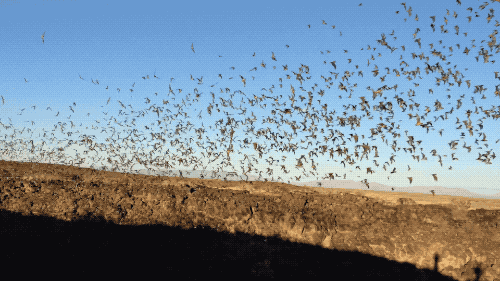
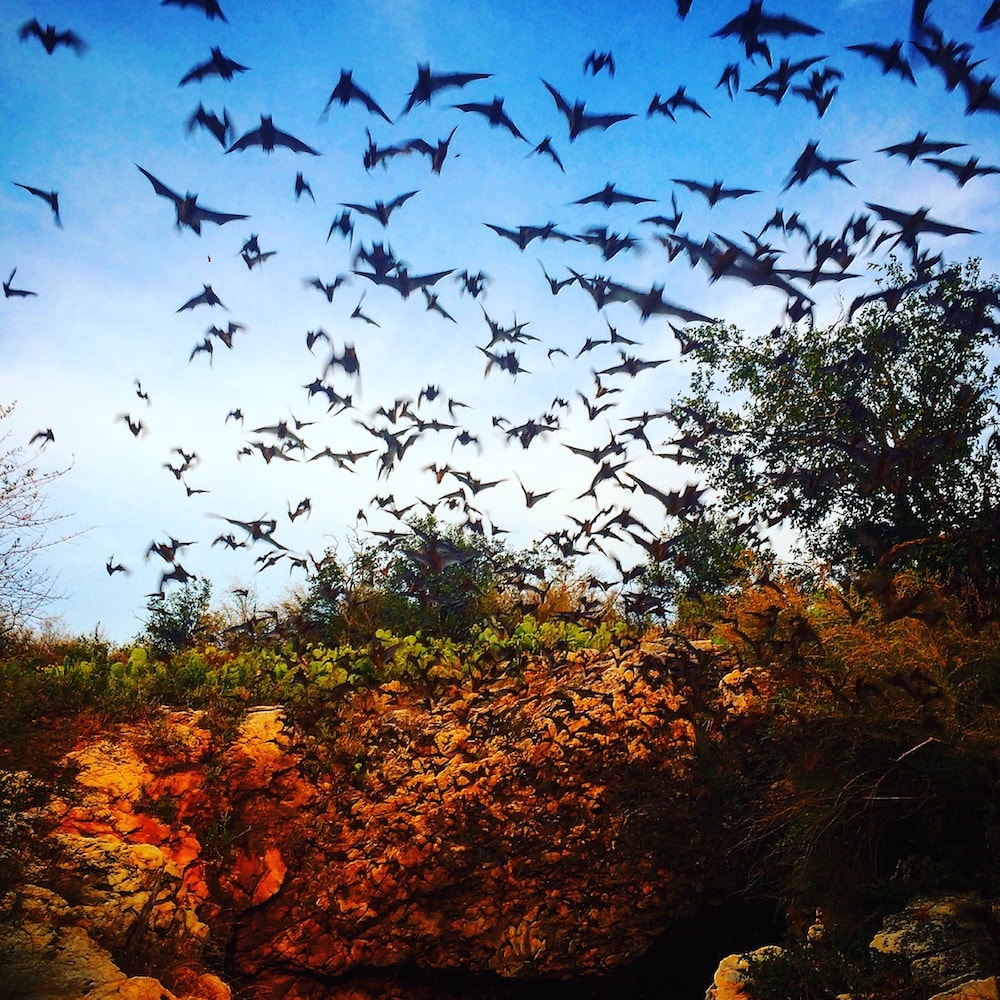
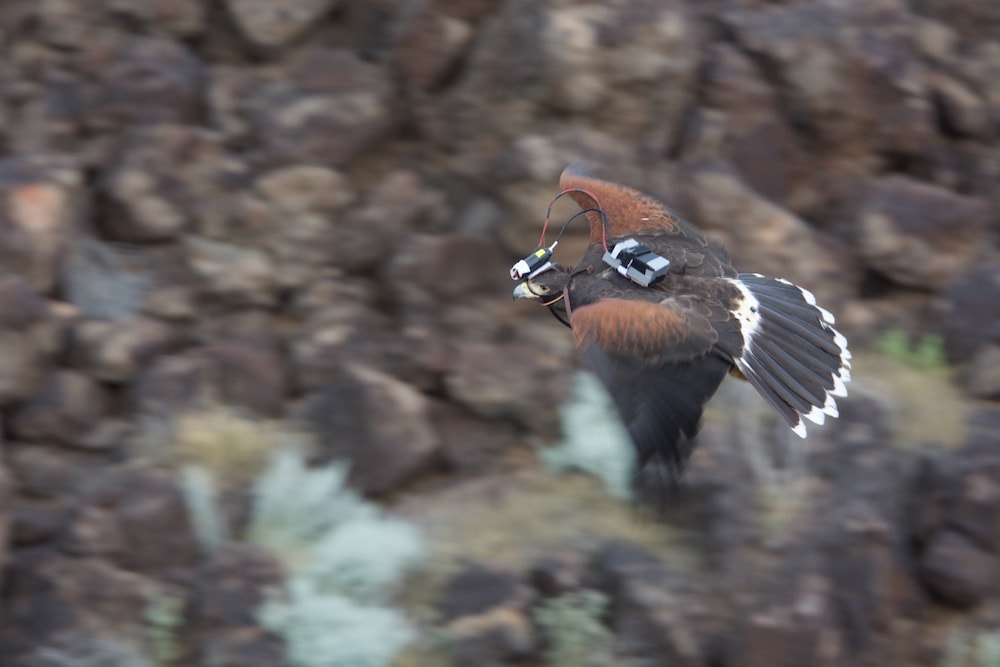
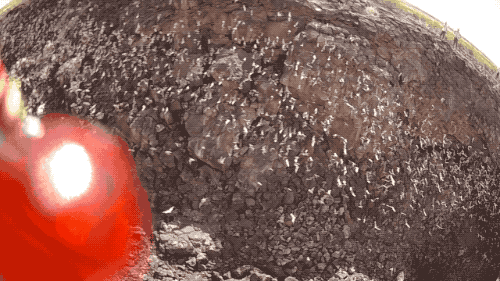
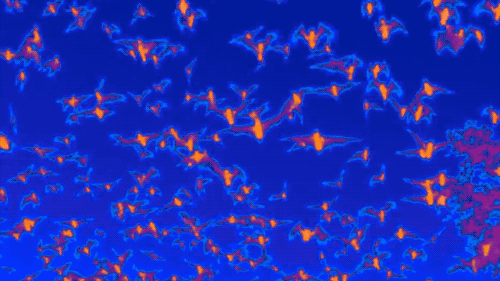
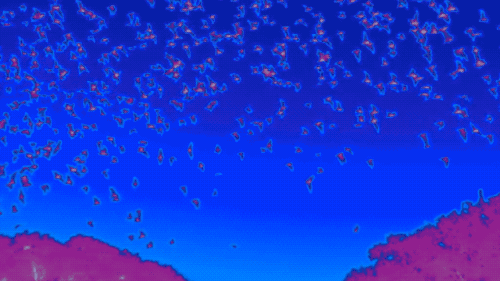
Laura Kloepper is an Assistant Professor in the Department of Biology at Saint Mary’s College in Notre Dame, Indiana.
IRA FLATOW: This is Science Friday. I’m Ira Flatow coming to you from the Brown Theater in Louisville, Kentucky.
[APPLAUSE]
And our theme tonight is, of course, on the rocks. And one of the things Kentucky is famous for is places where the rock isn’t actually there anymore. I didn’t know this. Did you know that Kentucky has 5,000 caves? 5,000 caves. I couldn’t believe that. And well, we had to see one of these caves for ourselves. So our Science Friday producers headed down Interstate 65 to visit Crumps Cave in southern Kentucky to tour the underground lab of a couple of cave scientists. And they sent us back this audio postcard.
JASON POLK: All right. So the first rule and first thing we should do is turn the lights on. This is Crumps Cave. We are going to go down and unlock the gate to the cave. And we’ll walk down a small trail about 50 feet or so. And we’ll go to a waterfall. And in the waterfall, we have all of our research equipment set up. I am Jason Polk, and I am an associate professor of geosciences at Western Kentucky University. And I also directs the Center for Human Geo-environmental Studies.
FERNANDO HERNANDEZ: I am Fernando Hernandez, and I am a grad student over here Western Kentucky. And I’m studying springs in the Cumberland plateau in Tennessee.
[METAL BANGING]
JASON POLK: Just be careful of your footing in this first part because it’s just loose rocks. So that sound you hear is water that is flowing out of a layer in the rock and falling as a waterfall. And will flow until it reaches the actual water table for the region. Look at this.
SPEAKER 1: Whoa, what is that?
JASON POLK: Just a cave cricket.
FERNANDO HERNANDEZ: They’re one of the main sources of energy inside the cave. So all the other creatures that live inside, some of them never go out. But the crickets, every night, they go outside of the cave, forage, come back. And other critters like salamanders or even pseudo scorpions or smaller things that are living inside the cave eat either them or their poop or something out of them. So they’re normally the backbone of the whole food cycle in the cave. So they’re small and tiny, but they’re really important inside here.
SPEAKER 1: Looks like you got a bunch of leaky buckets over here.
JASON POLK: We definitely do. This is our monitoring station. So we capture the water in the barrel to measure the level and flow. And then it flows into a smaller bucket where we have the [? saun ?] with the probes. It’s like taking a little snapshot. You know, we’re able to pull a sample and capture it before it becomes part of the overall system.
And from those water samples, we’ll analyze them for things like E. coli. We’ll look at all the different dissolved chemicals in the water. We can analyze for things like atrazine, which is a really commonly used herbicide here in Kentucky. We’re going to walk down to the next waterfall that’s in the cave. Everybody just watch your step. And
About 25% of the world’s population, so literally billions of people depend on these types of systems for their drinking water. A lot of people don’t really understand all the things we study with pollution and contaminants and whatnot all does have a bigger impact too. This is the end of the portion of the cave that we own and what’s really safe for us to keep doing without some additional training and gear. But anybody want a cricket for the road? If not, then we’ll make our escape because it’s cold here.
IRA FLATOW: Yeah. Crickets. Mm. They do say that it is the food of the future. So that was Jason Polk and Fernando Hernandez at Western Kentucky University at Crumps Cave. And if you’ve ever had the chance to visit a cave, one of the things you might have seen is the incredible spectacle of huge swarms of bats flying out of the cave at incredibly fast speeds. I mean, you’re talking thousands of bats.
But did you ever wonder how they do that without hitting each other, without running into each other? Or you say, oh yeah, I’ve heard about that echolocation. Well let me play you a sample of what echolocating bats leaving the bat cave sounds like.
[AUDIO PLAYBACK]
[END PLAYBACK]
Sounds like a little sand, right? You really can’t make any sense out of it. It’s hard to understand. So I’m going to slow it down for you a little. I’m going to slow it down to make it 20 times slower.
[AUDIO PLAYBACK]
[END PLAYBACK]
Still confused by that. How do they know where they’re going? And how did they know not to hit each other? The bats are somehow able to use these signals to communicate with themselves perfectly in their swarms? So we humans may have a lot to learn about how to communicate and how to echolocate from these bats.
And my next guest says she wants to save the world by studying bats. How she’s going to do that, I don’t know. But we’re going to ask her. Laura Klepper is an assistant professor of biology at Saint Mary’s College in Notre Dame, Indiana. Welcome to Science Friday.
[APPLAUSE]
LAURA KLEPPER: Thank you very much for having me.
[APPLAUSE]
IRA FLATOW: Now you say you study the bats to save the world. What do you mean by that?
LAURA KLEPPER: Well, that’s my tagline that I give people. So as any good scientist, we have to be able to explain why we do what we do, in terms of the societal relevance or why aside from just the pure interest in wanting to do science. What is the benefit for humanity?
So I study biological sonar. I study not just bats, I also study dolphins. So both of those animals use biological sonar. And we’ve been studying these animals for almost a century now in order to do what we call biomimicry, which is to understand what the animals are doing to do something that benefits us. And for us, that would be sonar. So by studying these animals, we’re learning how to make our own sonar devices.
IRA FLATOW: Now, well we use sonar and submarines and things like that. But it seems like the bats have really got it down differently. It’s a much more complex thing that they’re doing.
LAURA KLEPPER: It is incredible. In fact, basically what they’re doing– the reason why I study what the bats are doing– is that all we know about science, physics, biology, says that they’re doing an impossible task by echolocating in these large groups. What we know about how echolocation works is that when they’re in these groups, the signals from each bat should be interfering with each other. And they should not be able to be using their sonar. They should be jamming their sonar and colliding and falling to the ground. But despite what we think is impossible, the bats are doing this. And they’ve been doing it this way for millions of years. So that just means we’re missing part of the equation.
IRA FLATOW: Must be missing a lot of that part–
LAURA KLEPPER: We are missing quite a lot
IRA FLATOW: –of the equation. I understand that you’ve invented some unusual ways to study these bats from actually within the swarm. You get into the swarm?
LAURA KLEPPER: Yeah. You know, I like to say that as a scientist, I have the coolest job on the planet because I get paid to develop and play with really cool toys. And then I get to take my toys to really fun locations. And then I get to tell everybody about the fun I’m doing in the field.
So one of the questions that I am ultimately wanting to get at is, what is it like to be a bat. And in order to really understand what it’s like to be a bat, you need to get inside the swarm of those bats. You have to pretend like you’re a bat. Now I can’t put on my Batman costume and fly into the swarm of the bats. So we invented a few unusual technologies in order to do this and get inside the swarm.
IRA FLATOW: So such as?
LAURA KLEPPER: Zip lines.
IRA FLATOW: Zip lines.
LAURA KLEPPER: Zip lines.
IRA FLATOW: You get on a zip line?
LAURA KLEPPER: Ah, no, no, no, no, no. I do not. No. I do not get on a zip line. We put our recorders on a zip line. And we fly our zip lines through the swarm of the bats so that we have our recording microphone matching the speed of the bats as it’s going through the bat swarm. We also use drones.
IRA FLATOW: Drones.
LAURA KLEPPER: We fly drones.
IRA FLATOW: Makes sense.
LAURA KLEPPER: Yes, we put the drones up to get up off the ground. And then probably a favorite among the students in my lab is we have a hawk that we use to fly through the bats.
IRA FLATOW: Hawk is not eating lunch going through the bats, is it?
LAURA KLEPPER: No, no. Our hawk is not eating the bats. We’ve trained this hawk. Our hawk is named Belle after our school’s mascot, the St. Mary’s Bells. We have trained this hawk. It’s been raised ever since it was a chick, so it’s been hand raised. And it knows it just flies from handler to handler. And it gets jack rabbit as its reward because we’re in the fields of New Mexico. And this hawk carries a custom-built microphone and video unit, and flies through the bats to get video and audio recording for us of the bats within the swarm.
IRA FLATOW: OK, so let’s say I understand that you’re trying to understand how good the bats are and how they do this. What kind of applications would you use the sonar that they do?
LAURA KLEPPER: Right. So we use sonar in a lot of devices in everyday life. Sonar, for example, we use it to map the ocean floor. We use a form of sonar for self-driving vehicles underwater or for fish finders. Self-driving cars, they don’t use sonar exactly. They use radar. But the same processing is the same idea.
So one of the technological problems that we’re working on, as we have this rise in technology in our society, is the need for automated transport, automated sensing is growing. And how you can have multiple vehicles in space using sonar is something that we haven’t quite figured out. So we’re looking to the bats for the solution.
IRA FLATOW: You know that really just hit home with me because we’re talking about having thousands of cars on the road not hitting each other. The bats have figured out how to do that already. Tens of thousands of bats not bumping into each other. And that’s what you want to know. How they do that.
LAURA KLEPPER: Well, that’s what I hope to answer.
IRA FLATOW: All right, tell us what it’s like. So you follow these bats or tens of thousands of bats. It could be even more than that, right? What’s a bat cave really like?
LAURA KLEPPER: A bat cave is one of the coolest habitats on the planet. I’m a little biased. So let’s see if I can take you into a bat cave.
IRA FLATOW: Take me in.
LAURA KLEPPER: Take you into a bat cave. So first of all, you can’t just walk into a bat cave like this. We have to protect both the bats from us as well as us from the bats. So we wear sterile protective suits, waterproof Tyvek suits. Additionally, inside the bat cave, the caves I go to have about a half million bats or so.
IRA FLATOW: Wait a minute. A half million in the cave?
LAURA KLEPPER: Oh yeah.
IRA FLATOW: One cave? Well look how you’re looking at me like that. Like that’s really cool.
LAURA KLEPPER: It’s so cool.
IRA FLATOW: So you wear this special outfit.
LAURA KLEPPER: Tyvek suit. And we also have to wear a full face respirator because there’s so many bats inside the cave. They’re urinating. They’re defecating. So the ammonia levels are very high. So we have to protect our breathing. And there’s also a toxic fungal spore inside the cave, histoplasmosis, which can cause all kinds of respiratory ailments. So we wear a lot of protective gear inside the cave. But that’s not even the coolest part. So when you enter the cave–
IRA FLATOW: You got me. I’m waiting for the coolest part.
LAURA KLEPPER: I wish I could take you there tonight, Ira. It’s fantastic.
IRA FLATOW: What time is it?
LAURA KLEPPER: So when you start walking into the cave, you have all these bats inside a cave. And the bats are– they’re always defecating. So the guano starts to build up, and it builds up like a giant sand dune inside the cave. So when we enter the cave, we walk up the sand dune. And you kind of squish down. You squish into it.
But not just that, there’s all these insects in the cave that live off of the guano as well as– it’s a maternal cave, so there’s baby bats that are just born. And baby bats, there’s a high mortality rate from the newborns. They fall from the cave ceiling. So the moment they land on the ground, there’s a special type of beetle that starts eating the flesh of the baby bats alive. So the whole ground is moving and just seething with this movement.
IRA FLATOW: So you’re crawling up a mountain of guano.
[LAUGHTER]
The floor is moving all around you. There are bats hanging from the ceiling.
LAURA KLEPPER: No, no, no. They’re flying around. You’ve disturbed them at this point.
IRA FLATOW: They’re flying around.
LAURA KLEPPER: So they’re smacking into your head left and right.
IRA FLATOW: Are they smacking? People afraid that bats get in your hair. Is that a myth? Or do they–
LAURA KLEPPER: Well, we cover our heads.
IRA FLATOW: But how about, if you have 100,000 bats or whatever in a cave–
LAURA KLEPPER: 500,000.
IRA FLATOW: Excuse me. I don’t mean to short change it. Now they have all that body heat. Do heat the cave up?
LAURA KLEPPER: They do. That cave gets very hot. In fact, when they’re in the cave in tight clusters, the temperature inside the clusters of the bats can exceed the body temperature. We know this because we take special thermal cameras in there that can tell us the exact temperature measurement from within the cave.
So because they can create such high temperatures, that’s part of the reason also why they’re always moving around and milling about within the cave, is to get rid of some of those temperatures. And just being in the cave too, it’s very hot as a researcher because you’re wearing a suit that doesn’t breathe. So you get very sweaty.
IRA FLATOW: How often do you do this?
LAURA KLEPPER: I do this every summer for a month with my undergraduate students.
IRA FLATOW: And look at you smiling about this.
LAURA KLEPPER: It’s fantastic.
[LAUGHTER]
IRA FLATOW: This is Science Friday from PRI, Public Radio International. Talking with Laura Klepper, Assistant Professor of Biology at Saint Mary’s College in Notre Dame, Indiana. I don’t think there’s a person who loves bats more than you do.
LAURA KLEPPER: I don’t know. There might be a few out there.
IRA FLATOW: Few out there. Now, I understand– a little birdie told me that you do a mean bat impression.
LAURA KLEPPER: Oh yeah, I do.
IRA FLATOW: Come on. Give us. Don’t you want to see her impression?
[APPLAUSE]
LAURA KLEPPER: Well, I have to give you a little bit of back story beforehand. So first of all, when the bats are echolocating, they’re not just keeping their head straight. They’re scanning their environment with their heads, as well as, they can move their ears independently to perceive the echo. So when I do my bat impression, I go,
[IMITATES BAT]
[APPLAUSE]
IRA FLATOW: Wow. We’ve had a lot of demonstrations on Science Friday, but never such a unique bat impression.
LAURA KLEPPER: You know, you spend a lot of time with bats, and you begin to learn them a little bit.
IRA FLATOW: Go batty.
LAURA KLEPPER: Well, perhaps.
IRA FLATOW: Where did that expression come from? Did it have anything to do with bats, going batty?
LAURA KLEPPER: I believe it does. Yeah, I believe it has to do with some of the chemicals inside the bat cave.
IRA FLATOW: Yeah.
LAURA KLEPPER: Yeah.
IRA FLATOW: You know, I love that little thing you did, the sound. Can you do it to the sound one more time? I’m a sound guy. I love that.
LAURA KLEPPER: Well, do you want to hear my slowed down bat call? Because that’s in real time.
IRA FLATOW: Absolutely. Slowed down bat call by Laura Klepper.
LAURA KLEPPER: So back story. I have to give back story as a scientist. So these bats make what we call frequency modulated calls, which means they change in pitch over time. So although in real time, we might hear, [IMITATES BAT] really, what they’re doing is they’re going, pew! Pew! Pew!
[LAUGHTER]
[APPLAUSE]
IRA FLATOW: Wow. Who knew? Two for the price of one. That’s great. Can you teach that? Do you teach that to your students?
LAURA KLEPPER: My students actually do a fantastic bat impression. It’s part of the assignment in my lab.
IRA FLATOW: On a Friday night, when you’re getting together after the lab is done, you’re all doing the bat call together any time?
LAURA KLEPPER: It’s kind of our signal to call each other at times in the hallway.
[LAUGHTER]
IRA FLATOW: Now I understand that you teach an all women’s undergraduate college.
LAURA KLEPPER: I do. I do.
IRA FLATOW: And I understand that it’s been a great opportunity for you to get many young women involved in this field.
LAURA KLEPPER: It is. Yeah. I have a really lively group of students. I’ve gotten lots of students excited about bats despite them never thinking they would be excited about bats. So we try to help spread the bat love and the bat joy around our campus.
IRA FLATOW: Let’s see if anybody in our audience. Yes? Step up. Go ahead.
AUDIENCE: You mentioned how your work could save the world. Not too many years ago on All Things Considered, there was a echolocation story about Daniel Kish, how he could ride a bike. Can you comment on how a human could develop that?
LAURA KLEPPER: Right. So there’s a lot of people in my field that are trying to study human echolocation to understand exactly the mechanism with it. But when I work with school groups, I like to do a demo to show that we are all capable of a very rudimentary form of echolocation. I have a person close their eyes, and it’s this clicking mechanism. This [CLICKING NOISE]
It makes what we call a broadband signal, which has a wide range of frequencies. And because it’s a short duration, impulsive signal, it gives you really good information about your environment. And so I encourage you all to go home tonight and practice. And if you have someone put something up in front of your face with your eyes closed while you’re clicking, you can actually detect the difference with your ear. And so it’s thought that when people lose one of their senses, especially with vision, their hearing can become even more heightened. And so that’s how they’re able to use their echolocation.
IRA FLATOW: Well Dr. Klepper, this is incredibly fascinating. I want to thank you for taking time to be with us today.
LAURA KLEPPER: Thank you.
[APPLAUSE]
IRA FLATOW: Laura Klepper is an assistant professor of biology at Saint Mary’s College in Notre Dame, Indiana. And playing us to the break, Bridge 19.
[MUSIC PLAYING]
Copyright © 2017 Science Friday Initiative. All rights reserved. Science Friday transcripts are produced on a tight deadline by 3Play Media. Fidelity to the original aired/published audio or video file might vary, and text might be updated or amended in the future. For the authoritative record of Science Friday’s programming, please visit the original aired/published recording. For terms of use and more information, visit our policies pages at http://www.sciencefriday.com/about/policies/
Christopher Intagliata was Science Friday’s senior producer. He once served as a prop in an optical illusion and speaks passable Ira Flatowese.